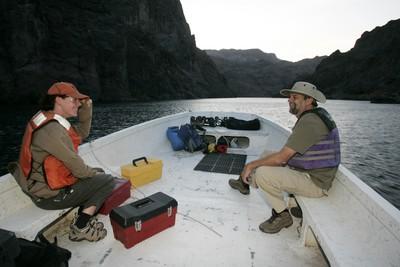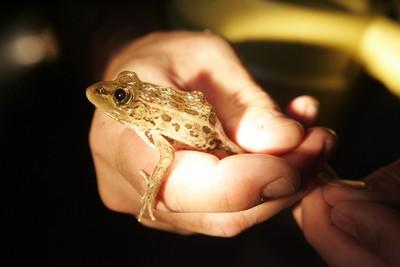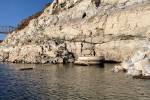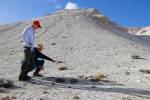RARE FROGS AREN’T CROAKING
With their spotlights shining on a spring-fed creek off Lake Mohave, biologists Jef Jaeger and Dana Drake searched for one of the rarest creatures in Nevada, a once-forgotten frog that was thought to have gone extinct more than 50 years ago.
It was a few minutes after 8 o'clock Wednesday night when the first pair of dark eyes from a relict leopard frog poked from a puddle alongside the creek. The sheen of its olive-drab skin shimmered in the lights' beams.
"There he goes," said Jaeger, following the frog with his light as it hopped three times then ducked beneath a clump of weeds.
He took a few more steps up the brush-covered ravine when another frog leaped.
"Here's one we missed," said Jaeger, an assistant research professor for the Public Lands Institute, a research arm of the University of Nevada, Las Vegas.
Drake, a research assistant, walked toward a puddle at the base of a steep rock wall. "There's another one," she said.
"No. 3 leopard frog; 24 toads," she said, stopping to jot down the number in a notebook for what's called the "visual encounter survey."
"I've got a juvenile relict leopard frog. That's really cool," Jaeger said.
Already, the survey was encouraging for the continued existence of this throng of relict leopard frogs, one of seven places on lakes Mead and Mohave where they thrive in the wild.
By night's end, 75 adult and juvenile relict leopard frogs as well as several tadpoles had been counted on the survey routes where they coexist with many more red-spotted toads, a few snakes, coyotes, bighorn sheep and an occasional mountain lion.
In 2001, the population of adult frogs stood at roughly 1,100 around both lakes. While they have vanished from a couple of sites, their numbers at some of these more recently discovered sites indicate that at least for now the world's only relict leopard frogs in the wild are holding their ground.
At this location, known among biologists as "salt cedar," a flash flood on Oct. 14 knocked down stands of tamarisk and mesquite trees that in previous years had clogged the habitat.
"The water appears to have gotten up to 9-feet-tall and blew this vegetation out. You could not possibly walk in here at all," Jaeger said.
At another survey site a short distance away by boat, the flood had enhanced the habitat for relict leopard frogs, creating bathtub-size puddles scattered among debris along a creek, making the prospect for breeding ideal.
"The population definitely responded in a positive fashion to the disturbance," Jaeger said. "There are a lot more open pools. This certainly opened the system up. It removed the dense vegetation and now we're seeing a whole lot of juveniles."
Another half dozen sites in the national recreation area have been stocked with the frogs raised from eggs in aquariums at a National Park Service facility in Boulder City, the hub of the Relict Leopard Frog Conservation Team.
The team's chairman, Ross Haley, said it's uncertain how widespread the relict leopard frog population was before the Colorado River was dammed in the 1930s to form Lake Mead. But he presumes a number of old habitats for the frogs are now at the bottom of both Mead and Mohave.
Haley, a National Park Service biologist, chronicled the relict leopard frog's history dating back to 1872 when a specimen collected along the Virgin River in Washington County, Utah, was described three years later as the species.
Over a span of several decades, however, scientists debated the relict leopard frog's identification. The confusion centered on populations of leopard frogs found in the Las Vegas Valley in 1906 that are now extinct and were thought by some scientists to be a different species.
Despite the discrepancy, scientists thought the relict leopard frog had gone extinct by 1950 after the last specimens were collected from Berry Spring in Washington County.
Then in 1974, according to Haley's research, an unpublished correspondence from Lake Mead National Recreation Area noted that frogs existed at Blue Point and Rogers springs south of Overton Beach. It was unclear what kind they were.
Finally, on April 24, 1991, Haley caught and observed frogs at nearby Blue Point and Corral springs. They were confirmed to be relict leopard frogs.
Six years later, Jaeger and a colleague, Dave Bradford, discovered three more populations at sites along Lake Mohave.
As scientists continued to monitor the population, translocation efforts sprouted with the first batch of nearly 300 frogs raised in captivity transplanted in a local wetlands in 2000.
The following year, the interagency Relict Leopard Frog Conservation Team was formed to carry out a management plan and later a conservation agreement and strategy for the frog.
In 2002, before about two dozen tadpoles were transported to the Detroit Zoo to establish a breeding program, the Center for Biological Diversity and Southern Utah Wilderness Alliance petitioned the U.S. Fish and Wildlife Service to list the relict leopard frog as an endangered species.
The service, instead, declared it a candidate for listing given that the conservation team had already taken steps to protect and monitor the frog.
"We are doing this without the listing, without the hammer over people's heads," Haley said. "We tried to be proactive."
As part of the protection effort, the team is trying to distribute the frog to other areas. "The wisdom behind that is you don't want to put all your frogs in one basket," Haley said.
"With massive flooding events and fires you could easily lose the species if there are only one or two springs that have them."
For a number of reasons it's important to preserve the relict leopard frog, not the least of which is maintaining nature's genetic library that could produce beneficial substances for future human use, such as cures for diseases.
"The first rule of intelligent tinkering is to save all the parts," he said.
"If you don't understand the system you don't want to be unpleasantly surprised to find out that some part you thought was unimportant is very important."
Jaeger said the relict leopard frog is arguably one of the most endangered animals in Southern Nevada.
"It's a rival for that notorious distinction with the Devil's Hole pupfish," he said.



























